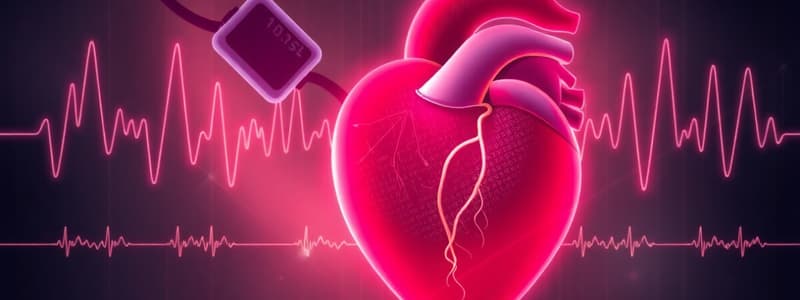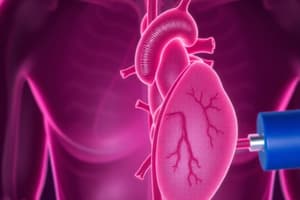Podcast
Questions and Answers
What device is commonly used to monitor blood pressure?
What device is commonly used to monitor blood pressure?
- Aneurysmal Sphygmomanometer
- Digital Thermometer
- Mercurial Sphygmomanometer (correct)
- Electrocardiogram
The pulse pressure is calculated by subtracting diastolic pressure from systolic pressure.
The pulse pressure is calculated by subtracting diastolic pressure from systolic pressure.
True (A)
What is the main purpose of a stethoscope in blood pressure measurement?
What is the main purpose of a stethoscope in blood pressure measurement?
To listen to physiological sounds.
The average arterial blood pressure (MABP) can be calculated using the formula: DP + (SP - DP) / ______
The average arterial blood pressure (MABP) can be calculated using the formula: DP + (SP - DP) / ______
Match the following blood pressure components with their definitions:
Match the following blood pressure components with their definitions:
Which statement is true regarding the aneroid sphygmomanometer?
Which statement is true regarding the aneroid sphygmomanometer?
What is the most common location for taking a pulse?
What is the most common location for taking a pulse?
What does pulse pressure indicate?
What does pulse pressure indicate?
Aneroid sphygmomanometers are considered less accurate than mercurial sphygmomanometers.
Aneroid sphygmomanometers are considered less accurate than mercurial sphygmomanometers.
The normal resting heart rate for adults ranges from 50-90 beats per minute.
The normal resting heart rate for adults ranges from 50-90 beats per minute.
What is the average resting heart rate for a well-trained athlete?
What is the average resting heart rate for a well-trained athlete?
The sound 'lub' corresponds to the closure of the __________ valves.
The sound 'lub' corresponds to the closure of the __________ valves.
Which age group has a normal resting heart rate of 80-190 beats per minute?
Which age group has a normal resting heart rate of 80-190 beats per minute?
Match the age group with their corresponding normal resting heart rate:
Match the age group with their corresponding normal resting heart rate:
Korotkoff sounds are produced by laminar flow in arteries.
Korotkoff sounds are produced by laminar flow in arteries.
Mean arterial pressure (MAP) is the average __________ pressure throughout one cardiac cycle.
Mean arterial pressure (MAP) is the average __________ pressure throughout one cardiac cycle.
Flashcards are hidden until you start studying
Study Notes
Blood Pressure Measurement
- Blood pressure is measured using a sphygmomanometer, which can be either mercury-based or aneroid.
- The pressure in the cuff is calibrated in mmHg.
- A stethoscope is used to listen for the Korotkoff sounds, which are caused by turbulent blood flow in the arteries as the pressure is released from the cuff.
Cardiac Cycle and Heart Sounds
- The "lub" sound occurs when the mitral and tricuspid valves close, marking the start of systole (ventricular contraction).
- The "dub" sound occurs when the aortic and pulmonic valves close, marking the end of systole and the start of diastole (ventricular relaxation).
Mean Arterial Blood Pressure (MAP)
- MAP is the average arterial pressure throughout one cardiac cycle (systole and diastole).
- MAP is calculated as: Diastolic Pressure + (Systolic Pressure - Diastolic Pressure)/3.
- MAP is an important indicator of tissue perfusion, as it reflects the pressure driving blood flow to the organs.
Pulse Pressure
- Pulse pressure is the difference between systolic and diastolic pressures.
- It represents the pressure driving blood through the systemic circulation.
- An increased pulse pressure can indicate increased stroke volume or decreased vascular compliance (stiffening of arteries).
Normal Heart Rates
- The normal resting heart rate for adults and children over 10 years old is 60-100 beats per minute.
- Well-trained athletes may have a normal resting heart rate of 40-60 beats per minute.
- Newborns (up to 1 month old): 70-190 beats per minute
- Infants (1-11 months old): 80-160 beats per minute
- Children (1-2 years old): 80-130 beats per minute
- Children (3-4 years old): 80-120 beats per minute
- Children (5-6 years old): 75-115 beats per minute
- Children (7-9 years old): 70-110 beats per minute
Studying That Suits You
Use AI to generate personalized quizzes and flashcards to suit your learning preferences.




